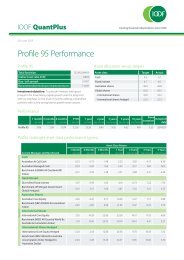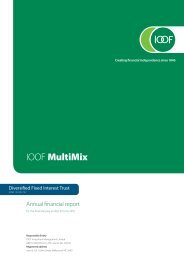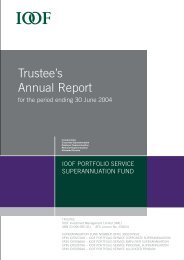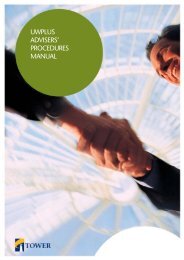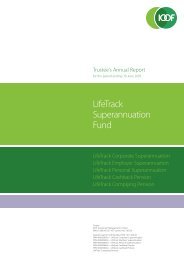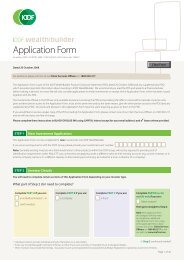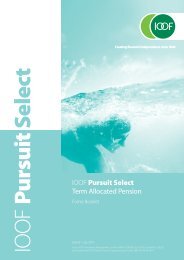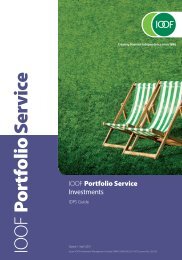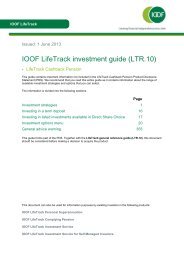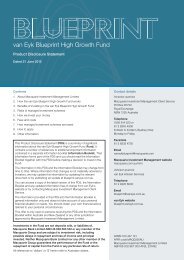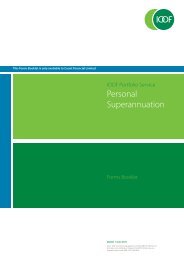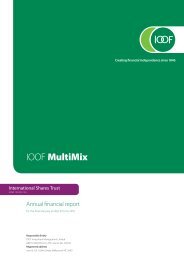annual report 2011
annual report 2011
annual report 2011
Create successful ePaper yourself
Turn your PDF publications into a flip-book with our unique Google optimized e-Paper software.
IOOF | <strong>annual</strong> <strong>report</strong> <strong>2011</strong><br />
The estimated useful lives for the current and comparative years are<br />
as follows:<br />
• adviser relationships 5 - 10 years<br />
• computer software 2½ - 4 years<br />
• customer relationships 10 - 20 years<br />
• brand names 20 years<br />
• contract agreements 9 - 10 years.<br />
Amortisation methods, useful lives and residual values are reviewed<br />
at each <strong>report</strong>ing date and adjusted if appropriate.<br />
(g) Leased assets<br />
Leases in terms of which the Group assumes substantially all the risks<br />
and rewards of ownership are classified as finance leases. Upon initial<br />
recognition the leased asset is measured at an amount equal to the<br />
lower of its fair value and the present value of the minimum lease<br />
payments. Subsequent to initial recognition, the asset is accounted<br />
for in accordance with the accounting policy applicable to that asset.<br />
Other leases are operating leases and are not recognised in the<br />
Group’s statement of financial position.<br />
(h) Impairment<br />
(i)<br />
Non-derivative financial assets<br />
A financial asset not carried at fair value through profit or loss is<br />
assessed at each <strong>report</strong>ing date to determine whether there is<br />
objective evidence that it is impaired. A financial asset is impaired if<br />
objective evidence indicates that a loss event has occurred after the<br />
initial recognition of the asset, and that the loss event had a negative<br />
effect on the estimated future cash flows of that asset that can be<br />
estimated reliably.<br />
Objective evidence that financial assets (including equity securities)<br />
are impaired can include default or delinquency by a debtor,<br />
restructuring of an amount due to the Group on terms that the<br />
Group would not consider otherwise, indications that a debtor or<br />
issuer will enter bankruptcy, adverse changes in the payment status<br />
of borrowers or issuers in the Group, economic conditions that<br />
correlate with defaults or the disappearance of an active market<br />
of a security. In addition, for an investment in an equity security,<br />
a significant or prolonged decline in its fair value below its cost is<br />
objective evidence of impairment.<br />
An impairment loss in respect of a financial asset measured at<br />
amortised cost is calculated as the difference between its carrying<br />
amount and the present value of the estimated future cash flows<br />
discounted at the asset’s original effective interest rate. Losses are<br />
recognised in profit or loss and reflected as an allowance account<br />
against loans and receivables. Interest on the impaired asset continues<br />
to be recognised. When a subsequent event (eg. a repayment by<br />
a debtor) causes the amount of impairment loss to decrease, the<br />
decrease in impairment loss is reversed through profit or loss.<br />
Available-for-sale financial assets<br />
Impairment losses on available-for-sale financial assets are<br />
recognised by reclassifying the losses accumulated in the<br />
investment revaluation reserve, to profit or loss. The cumulative<br />
loss that is reclassified from equity to profit or loss is the<br />
difference between the acquisition cost, net of any principal<br />
repayment and amortisation, and the current fair value, less any<br />
impairment loss previously recognised in profit or loss.<br />
Changes in impairment provisions attributable to application<br />
of the effective interest method are reflected as a component<br />
of interest income. If, in a subsequent period, the fair value of<br />
an impaired available-for-sale debt security increases and the<br />
increase can be related objectively to an event occurring after<br />
the impairment loss was recognised in profit or loss, then the<br />
impairment loss is reversed, with the amount of the reversal<br />
recognised in profit or loss. However, any subsequent recovery<br />
in the fair value of an impaired available-for-sale equity security<br />
is recognised in other comprehensive income.<br />
(ii)<br />
Non-financial assets<br />
The carrying amounts of the Group’s non-financial assets, other<br />
than deferred tax assets, are reviewed at each <strong>report</strong>ing date<br />
to determine whether there is any indication of impairment. If<br />
any such indication exists, then the asset’s recoverable amount<br />
is estimated. For goodwill, and intangible assets that have<br />
indefinite useful lives or that are not yet available for use, the<br />
recoverable amount is estimated each year at the same time.<br />
An impairment loss is recognised if the carrying amount of<br />
an asset or its related cash-generating unit (CGU) exceeds its<br />
estimated recoverable amount.<br />
The recoverable amount of an asset or cash-generating unit is<br />
the greater of its value in use and its fair value less costs to sell.<br />
In assessing value in use, the estimated future cash flows are<br />
discounted to their present value using a pre-tax discount rate<br />
that reflects current market assessments of the time value of<br />
money and the risks specific to the asset. For the purpose of<br />
impairment testing, assets that cannot be tested individually<br />
are grouped together into the smallest group of assets that<br />
generates cash inflows from continuing use that are largely<br />
independent of the cash inflows from continuing use of other<br />
assets or groups of assets (the cash-generating unit “CGU”).<br />
Subject to an operating segment ceiling test, for the purposes<br />
of goodwill impairment testing, CGUs to which goodwill has<br />
been allocated are aggregated so that the level at which<br />
impairment is tested reflects the lowest level at which goodwill<br />
is monitored for internal <strong>report</strong>ing purposes. Goodwill acquired<br />
in a business combination is allocated to groups of CGUs that<br />
are expected to benefit from the synergies of the combination.<br />
Impairment losses are recognised in profit or loss. Impairment<br />
losses recognised in respect of CGUs are allocated first to reduce<br />
page 59



